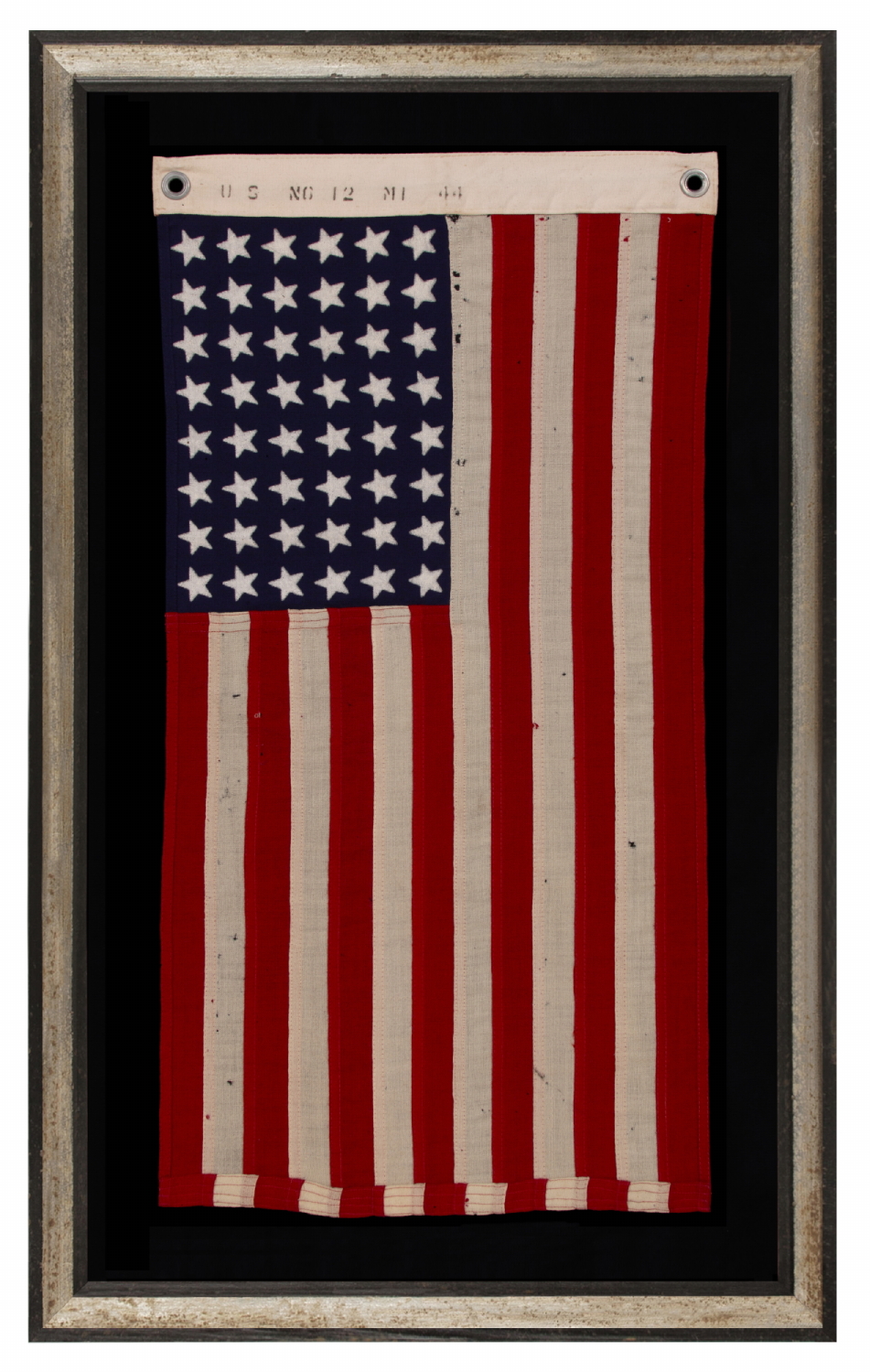


| 48 STAR, U.S. NAVY SMALL BOAT ENSIGN, MADE AT MARE ISLAND, CALIFORNIA DURING WWII, SIGNED AND DATED 1944, IN THE SMALLEST SCALE EMPLOYED AT THE TIME |
|
| Web ID: | 48j-1074 |
| Available: | In Stock |
| Frame Size (H x L): | Approx. 33" x 27" |
| Flag Size (H x L): | 32.75" x 17" |
| Description: | |
| 48 star American national flag, made during World War II (U.S. involvement 1941-45) at Mare Island, California, headquarters of the Pacific Fleet. A black stencil along the hoist on the reverse side reads as follows: "US NO 12 MI 44.” While U.S. involvement in the Second World War necessitated the acquisition of flags from many sources, the Navy had long made their own flags at several locations, of which this was one. "No. 12" is a size designation for a small boat flag that, per U.S. Navy Regulations of 1914, was to measure 1.31 x 2.49 feet. Located on the western edge of the City of Vallejo, about 23 miles northeast of San Francisco, Mare Island (actually a peninsula) served as a principal seat of U.S. Navy defense, beginning in the mid-19th century. The site was originally chosen following an expedition that set forth in 1850, when Commodore John Drake Sloat was ordered to lead a survey party in quest of a logical site for the nation's first Pacific naval installation. Sloat recommended the island across the Napa River from the settlement of Vallejo; it being "free from ocean gales and from floods and freshets." On November 6th of that year, two months after California was admitted to statehood, President Fillmore reserved Mare Island for government use. The U.S. Navy Department acted favorably on Commodore Sloat's recommendations and Mare Island was purchased in July, 1852, for the sum of $83,410 for the use as a naval shipyard. Two years later, on September 16th of 1854, Mare Island became the first permanent U.S. naval installation on the West Coast, with Commodore David G. Farragut serving as Mare Island's first base commander. The base became home to what was known as the Pacific Fleet, and remained so until the threat of Japanese expansionism caused the shift to a more advanced position at Pearl Harbor. It was very active in WWII, Korea, and Vietnam, but would eventually close in 1993 after Congress approved the findings of the Base Realignment and Closure Report. The canton and stripes of the flag are made of wool bunting that has been pieced and sewn with machine stitching. The stars are stamped or stenciled in white paint. This is a known technique in use in the manufacture of U.S. naval ensigns at the time and can be seen on other Mare Island flags. There is an especially wide canvas binding along the hoist with two noticeably large, white metal grommets. The weight of the wool and the stalwart construction is typical of what the Navy preferred in this period. The fabric is a heavier grade than what was typically employed in commercially-made flags of the time and the fly end is bound with 4 rows of stitching instead of the usual two encountered in standard, commercially-made flags. “No. 12” along the hoist binding is a size designation for U.S. Navy small boat ensigns. Measuring approx. 17" on the hoist by 32.75" on the fly, this was the smallest variety of Stars & Stripes in use by the Navy in 1944. In fact, these measurements are smaller than what was generally available at the time from commercial makers in widespread production. Smaller flags with sewn construction were available, and anything could be custom made, but surviving 48 star flags with sewn construction are extremely rare in sizes smaller the 2 x 3 feet. The dimensions of this particular U.S. Navy example make it great for a collector, because it can be so far more easily framed and displayed in an indoor setting. Although the specific history of the flag has been lost to time, the fact that it is signed and dated is likewise wonderful, at a time when almost nothing else was. The 48 star flag became official in 1912 following the addition of New Mexico and Arizona. It remained the official flag throughout WWI (U.S. involvement 1917-18), WWII (U.S. involvement 1941-45), and the Korean War (1950-53), until Alaska gained statehood in 1959 and the 49th star was added. Mounting: For 25 years we have maintained a specialized department for this purpose. Our lead conservator holds a master's degree in textile conservation from one of the nation’s top university programs. We take great care in the mounting and preservation of flags and related textiles and have preserved thousands of examples. The black-painted, hand-gilded, and distressed molding is Italian. The background is 100% cotton twill, black in color, that was washed and treated for colorfastness. The glazing is U.V. protective acrylic. Condition: There is minor to modest, scattered mothing throughout, accompanied by extremely minor staining along the binding. Many of my clients prefer early flags to show their age. The flag presents exceptionally well. |
|
| Video: | |
| Collector Level: | Beginners and Holiday Gift Giving |
| Flag Type: | Sewn flag |
| Star Count: | 48 |
| Earliest Date of Origin: | 1944 |
| Latest Date of Origin: | 1944 |
| State/Affiliation: | California |
| War Association: | WW 2 |
| Price: | Please call (717) 676-0545 or (717) 502-1281 |
| E-mail: | info@jeffbridgman.com |
 |
|